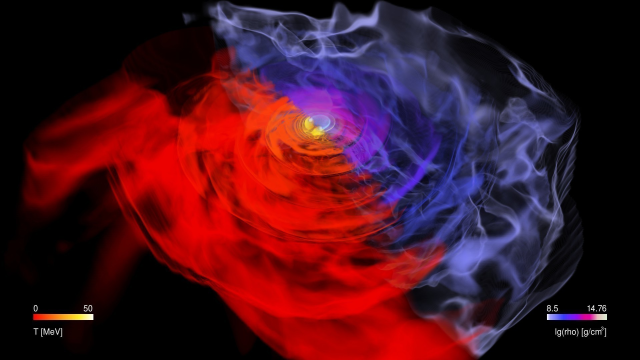Scientists are dreaming up ways to probe the nature of the universe’s smallest bits — quarks — by observing ultra-dense neutron stars slamming into each other.
Particle colliders in Switzerland and on Long Island, New York, have each seen evidence of a whole new form of matter in which quarks, rather than atoms, are the basic unit. But scientists think that neutron star collisions should also produce this kind of matter, and think that they might be able to spot it using gravitational wave detectors.
“We want an independent way to see quark matter,” Veronica Dexheimer, assistant professor in physics at Kent State University, told Gizmodo.
Matter is typically composed of atoms, which are in turn made from electrons, protons and neutrons; those protons and neutrons are themselves made of quarks.
But at high-enough energies and pressures, matter goes through a phase transition into quark matter or quark-gluon plasma, in which the constituent parts of protons and neutrons — the quarks — are no longer confined to atoms and become the smallest component of the matter.
Typically, scientists create quark matter in colliders by slamming atoms together at high energies. But you’d think that the incredible energies of colliding neutron stars — stellar corpses as massive as the Sun but only a few kilometres across — would create this kind of matter, too.
Scientists announced the first recorded instance of two neutron stars slamming together in August 2017, an event witnessed via the ripples in spacetime, called gravitational waves, that they produced.
Two new papers published this week in Physical Review Letters use computer simulations to predict two potential ways to observe quark matter produced during neutron star collisions, based on how it affects the gravitational wave signal.
One paper from researchers in Germany, as well as Dexheimer, proposes that the colliding neutron stars would present a differently shaped gravitational wave signal with a different phase after the neutron stars merge than theory otherwise predicts.
This would be the result of quark matter forming somewhat gradually throughout the collision before the whole system collapses into a black hole.
Another paper from an international team of researchers suggests that the collision immediately forms a core of quark matter at the centre. This would cause the gravitational waves to oscillate with higher-than-expected frequencies after the merger.
I asked an author from each paper what they thought of the other’s research, and both essentially felt that they represented two different, compatible ways to search for a similar phenomenon.
Both research teams have the same requirements in order to make their observations — they need upgrades at gravitational wave observatories like the US-based LIGO and the Europe-based Virgo.
“Basically, we need a higher sensitivity of the detectors at high frequencies, and we need a particularly close event,” said Andreas Bauswein, physicist at the GSI Helmholtz Centre for Heavy Ion Research in Darmstadt, Germany.
These events would need to be as close as, if not closer than, the August 2017 event, which took place 40 megaparsecs (130 million light-years) from Earth.
Now that scientists have actually observed the gravitational waves from colliding black holes and neutron stars, the excitement lies in what these waves might tell us about the nature of our strange universe.
